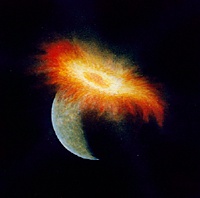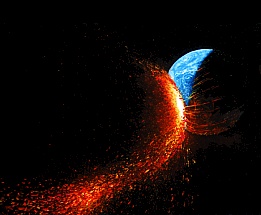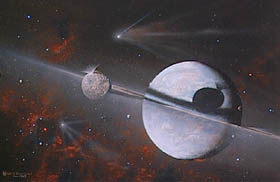
Through a tumult of theories about the creation of the moon, the Giant Impact Theory has gained precedence. It is believed that about 4.5 billion years ago while the Earth was still young, a planetary body roughly the size of Mars struck the Earth with enough force to eject some of the Earth's mass into orbit while demolishing the planetary body in the collision. The combined Earth, planetary body debris formed a ring about the Earth and was eventually swept up by increasing amounts of coalesced mass to form the Moon (Irion et. al. 2000).



The Mars sized body
that hit the
Earth had kinetic energy, or energy of motion which is equivalent to
one half
the mass times velocity squared:
KE = ½ mv²
The Mars
sized body also had momentum which is the product of its mass and
velocity:
p
= mv
On impact with
the
Earth, there was
a change in momentum equivalent to the impulse.
Impulse is the product of force and the time of the collision.
F∆t
= ∆p
If
the mass and velocity of the mars sized body that hit the Earth
billions of
years ago were known, we could compute the kinetic energy and change in
momentum of the giant impact that generated the Moon (Hecht 180, 210).